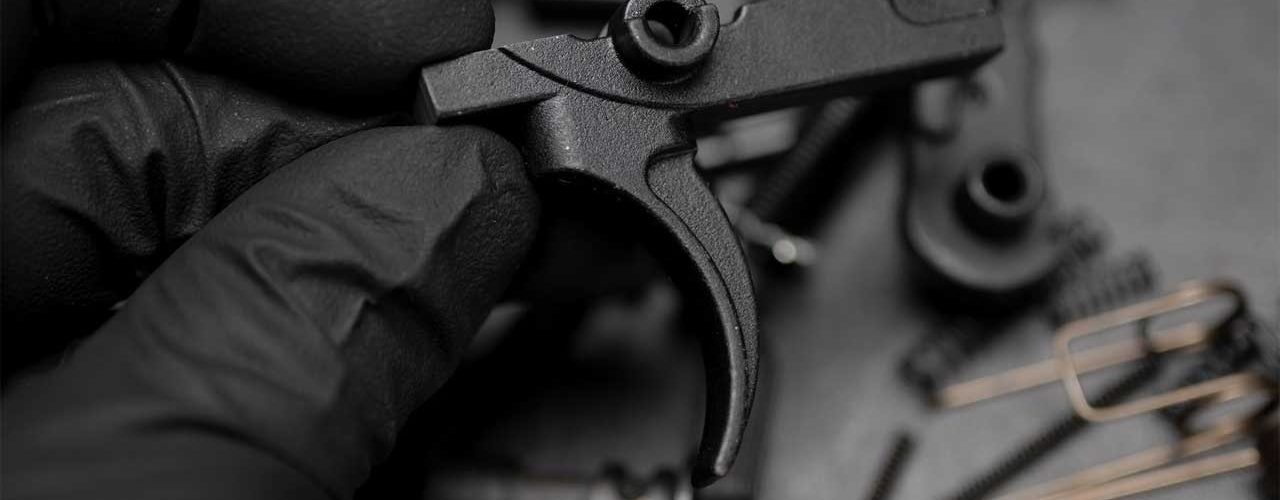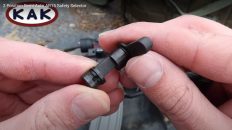Unlock the secrets of the AR-15 trigger and take your shooting skills to the next level. Whether you’re a seasoned shooter or a newbie to the gun world, understanding the mechanics of AR-15 parts can make all the difference in your accuracy and control. In this article, we will dive into the inner workings of the AR-15 trigger, breaking down its construction and exploring the various types available.
With its popularity among gun enthusiasts and sport shooters, the AR-15 has become a staple firearm in many collections. However, mastering the trigger can be a challenge, as it requires a combination of knowledge, skill, and practice. By understanding how the trigger functions and how to manipulate it effectively, you can improve your shooting performance and gain a greater understanding of this iconic rifle.
Join us as we explore the different types of AR-15 triggers, including single-stage, two-stage, and adjustable options. We’ll discuss their pros and cons, as well as provide tips on how to select the right trigger for your needs. Get ready to enhance your shooting experience by unlocking the secrets of the AR-15 trigger.
The Importance of Understanding the AR-15 Trigger
Understanding the AR-15 trigger is crucial for anyone looking to enhance their shooting skills. The trigger is a direct link between the shooter and the firearm; its mechanics can significantly affect accuracy and control. When a shooter pulls the trigger, various factors come into play, such as trigger weight, travel distance, and reset. Each of these elements can influence how a shooter experiences recoil and aligns their follow-up shots, making knowledge of the trigger’s operation essential for effective shooting.
Moreover, mastering the nuances of the AR-15 trigger can lead to improved marksmanship. A well-tuned trigger can aid in achieving a smooth and consistent pull, reducing the chances of jerking or pulling the shot off target. This is particularly important in precision shooting or competitive scenarios, where every fraction of an inch matters. Understanding the trigger helps shooters develop muscle memory, leading to better performance over time, regardless of the shooting discipline they engage in.
Lastly, knowing how the AR-15 trigger functions opens up opportunities for customization and upgrades. Shooters can tailor their triggers to suit personal preferences, from weight to feel. This customization not only enhances personal comfort but can also adapt the firearm for specific applications, such as hunting, tactical shooting, or recreational use. With the right knowledge, shooters can transform their AR-15 into an extension of themselves, making it a more effective tool for their shooting needs.
Different Types of AR-15 Triggers
When exploring the various types of AR-15 triggers, one must first understand the primary categories: single-stage and two-stage triggers. Single-stage triggers provide a direct pull with no noticeable travel before the break. This type is often preferred for tactical applications, where quick follow-up shots are necessary. The simplicity of a single-stage trigger allows for rapid firing, as the shooter can engage with minimal delay. However, some may find them less forgiving, especially if they are not accustomed to the feel of a quick, light trigger pull.
On the other hand, two-stage triggers offer a more nuanced experience. In this setup, the shooter experiences a slight amount of travel before the trigger engages, followed by a second, lighter pull that releases the hammer. This design allows for better control and precision, as the initial stage can help the shooter gauge readiness before the final break. Many precision shooters favor two-stage triggers for their ability to provide tactile feedback, helping to mitigate flinching and improving overall shot placement.
Adjustable triggers have also gained popularity, providing shooters with the ability to modify pull weight and travel distance. These versatile options can be fine-tuned to meet individual preferences or specific shooting situations. While adjustable triggers offer flexibility, they also require a certain level of knowledge and experience to set up correctly. Shooters need to be cautious about adjusting their triggers too light, as it can lead to unintended discharges or decreased safety during operation.
Choosing the Right Trigger for Your AR-15
Selecting the right trigger for your AR-15 involves considering several factors, including shooting style, purpose, and personal preference. For competitive shooters, a lighter trigger pull can be beneficial for quicker shots and better accuracy. A trigger weight between 3 to 4 pounds is often ideal for competitive applications, as it allows for a fast response while maintaining control. Conversely, those using their AR-15 for home defense or tactical purposes may prefer a heavier trigger pull, which can help prevent accidental discharges under stress.
Another important consideration is the type of shooting you intend to do. If you plan on using your AR-15 for long-range precision shooting, investing in a two-stage trigger may be the best option. This type allows for more controlled shooting, reducing the chances of flinching or jerking the trigger. If your focus is primarily on rapid-fire applications, a single-stage trigger might suit your needs better, providing a quick and responsive experience.
Finally, personal comfort with the trigger is paramount. It’s advisable to test different triggers before making a purchase. Many gun stores or shooting ranges offer the chance to handle various models, allowing you to feel the differences in pull weight and travel. Ultimately, the right trigger will enhance your shooting experience, making it essential to choose one that resonates with your individual shooting style and preferences.
How to Install an AR-15 Trigger
Installing an AR-15 trigger can be a rewarding DIY project, but it requires attention to detail and adherence to safety protocols. The first step in the installation process is to ensure that the firearm is completely unloaded and safe to work on. Always double-check that the magazine is removed and the chamber is clear. Once you’ve ensured safety, gather the necessary tools, which typically include a punch set, a hammer, and possibly a small torque wrench, depending on your trigger model.
Next, disassemble the lower receiver of the AR-15. This involves removing the pistol grip, buffer tube, and trigger guard. It’s essential to take your time during this process, documenting each step if necessary, to ensure a smooth reassembly. After removing the components, you’ll have access to the trigger assembly. Carefully remove the old trigger and hammer by driving out the pins with a punch and hammer. Pay close attention to the orientation of the components, as this will be crucial when installing the new trigger.
With the old trigger out, it’s time to install the new one. Begin by placing the new trigger and hammer into their respective positions within the lower receiver. Align the pins and use your punch to secure them in place. Once everything is assembled, reattach the pistol grip and any other components you had removed earlier. Finally, perform a functionality check by cycling the action and confirming that the trigger operates smoothly. If everything feels right, you can go ahead and take your AR-15 to the range and enjoy your newly installed trigger.
Maintenance and Troubleshooting Tips for AR-15 Triggers
Regular maintenance is key to ensuring your AR-15 trigger operates effectively and safely. One of the first steps in trigger maintenance is to keep the assembly clean. Dirt, debris, and carbon buildup can accumulate over time, leading to a gritty or inconsistent trigger pull. To clean the trigger assembly, disassemble the lower receiver and use a soft brush and cleaning solvent to remove any residue. Be cautious not to use excessive force, as components are delicate and can be damaged easily.
Another important aspect of maintenance is lubrication. Using a high-quality lubricant, apply a small amount to the pivot points and contact surfaces of the trigger components. This will help reduce friction and promote smooth operation. However, be mindful not to over-lubricate, as excess oil can attract more dirt and debris, leading to potential malfunctions. A light, even coat will typically suffice for optimal performance.
If you encounter issues with your AR-15 trigger, troubleshooting is essential. Common problems include a heavy pull, inconsistent breaking, or failure to reset. If the trigger feels unusually heavy, it may be due to improper installation or a buildup of debris. Disassemble the trigger again and check for any obstruction. If the issue persists, you may need to consider adjusting the trigger weight or consulting the manufacturer for further guidance. Regular maintenance and prompt troubleshooting can help extend the life of your trigger and improve overall shooting performance.
Upgrading Your AR-15 Trigger for Improved Performance
Upgrading the AR-15 trigger is one of the most effective ways to enhance your shooting experience. Many shooters find that factory-installed triggers can be heavy or inconsistent, prompting them to seek aftermarket options. Upgrading can lead to a more responsive pull, better reset, and overall improved accuracy. When considering an upgrade, it’s essential to evaluate your specific needs, such as the type of shooting you engage in and your comfort level with trigger weights.
One popular upgrade is to replace a single-stage trigger with a two-stage trigger. This transition can provide more control and precision, especially for long-range shooting. A two-stage trigger allows shooters to take advantage of the initial travel to stabilize their aim before the final break. Many brands offer high-quality two-stage triggers that cater to various preferences, enabling shooters to find the perfect fit for their style.
Another option is to invest in a drop-in trigger. These triggers come pre-assembled and designed for easy installation, eliminating the need for detailed assembly. Drop-in triggers often provide enhanced performance compared to stock options, offering lighter pull weights and a smoother break. However, when upgrading, it’s crucial to perform thorough research and select a reputable brand known for reliability, as the trigger is a critical component of firearm safety and performance.
Legal Considerations and Restrictions for AR-15 Triggers
Navigating the legal landscape of AR-15 triggers is essential for responsible gun ownership. Laws regarding firearms can vary significantly by state and locality, and triggers are no exception. Some jurisdictions may impose restrictions on specific types of triggers, such as those that allow for fully automatic firing or rapid-fire capabilities. It’s vital for gun owners to familiarize themselves with local laws to ensure compliance and avoid potential legal issues.
Moreover, certain modifications to triggers may classify a firearm differently under the law. For example, changing a trigger to create a semi-automatic firearm that mimics automatic fire could lead to severe legal repercussions. Understanding the definition of what constitutes a legal firearm in your area is crucial. Always consult legal experts or local law enforcement if you have questions regarding specific modifications or upgrades.
Finally, staying informed about ongoing legislative changes is essential for responsible gun ownership. Gun laws can evolve, and what may be legal today could change tomorrow. Regularly reviewing state laws and staying engaged with local gun rights organizations can help gun owners navigate the complexities of firearm legislation and ensure they remain compliant with all regulations regarding AR-15 triggers.
Training and Practice with AR-15 Triggers
Training and practice are essential components of becoming proficient with your AR-15 trigger. Understanding the mechanics of the trigger is one thing, but applying that knowledge in real-world scenarios is where true skill develops. Regular practice at the range allows shooters to familiarize themselves with trigger pull weight, reset, and overall feel. Setting aside dedicated time for practice sessions can lead to significant improvements in shooting performance over time.
In addition to range time, incorporating dry-fire practice at home can be invaluable. Dry-firing allows shooters to practice trigger control and follow-through without the need for ammunition. This method helps to reinforce proper technique, enabling shooters to develop muscle memory for smooth trigger pulls. When performing dry-fire drills, focus on maintaining sight alignment and controlling breathing, as these factors are critical in achieving accurate shots.
Lastly, seeking professional training can accelerate the learning process. Many experienced instructors offer courses that focus specifically on trigger control and shooting techniques. Participating in structured training often provides valuable insights and feedback that can enhance performance. These courses also teach important concepts like managing recoil, which is essential for mastering trigger manipulation under various shooting conditions.
Conclusion: Becoming a Master of the AR-15 Trigger
Mastering the AR-15 trigger is a journey that requires dedication, practice, and a willingness to learn. By understanding the mechanics of the trigger and the different types available, shooters can make informed decisions about upgrades and customization. Regular maintenance and troubleshooting can help keep the trigger operating smoothly, ensuring reliability during critical moments.
Training and consistent practice lay the foundation for becoming proficient with the AR-15 trigger. Whether through range time, dry-fire exercises, or professional instruction, each step taken towards mastery contributes to improved marksmanship and overall confidence. As shooters continue to develop their skills, they can unlock the full potential of their AR-15, transforming it into a highly effective tool for various shooting applications.
With the right knowledge, experience, and commitment, anyone can become a master of the AR-15 trigger. Embrace the learning process, invest time in practice, and stay informed about legal considerations to enhance your shooting journey. The secrets of the AR-15 trigger are now within reach, poised to elevate your shooting performance to new heights.





Add comment